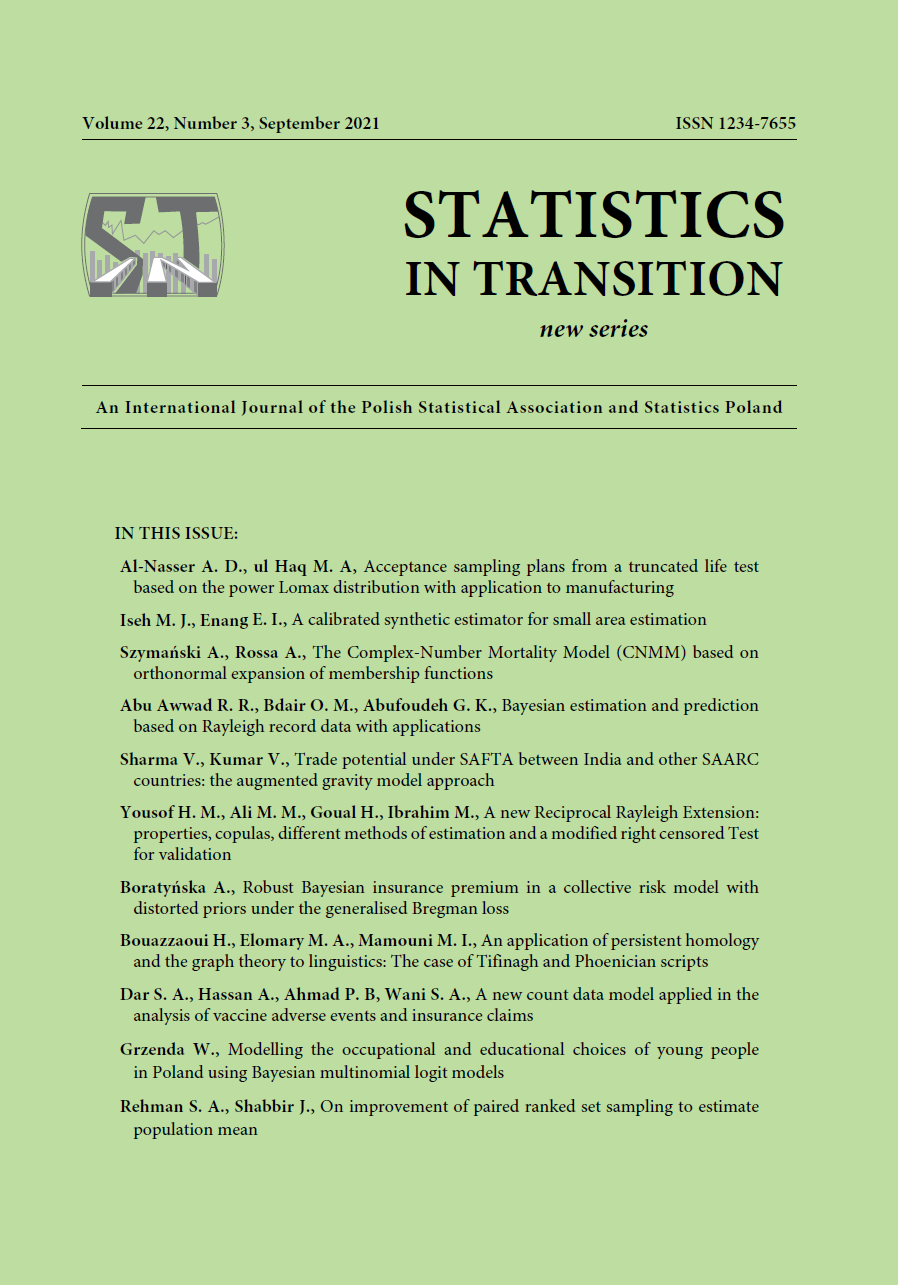ARTICLE
ABSTRACT
Synthetic estimators are known to produce estimates of population mean in areas where no sampled data are available, but such estimates are usually highly biased with invalid confidence statements. This paper presents a calibrated synthetic estimator of the population mean which addresses these problematic issues. Two known special cases of this estimator were obtained in the form of combined ratio and combined regression synthetic estimators, using selected tuning parameters under stratified sampling. In result, their biases and variance estimators were derived. The empirical demonstration of the usage involving the proposed calibrated estimators shows that they provide better estimates of the population mean than the existing estimators discussed in this study. In particular, the estimators were examined through simulation under three distributional assumptions, namely the normal, gamma and exponential distributions. The results show that they provide estimates of the mean displaying less relative bias and greater efficiency. Moreover, they prove more consistent than the existing classical synthetic estimator. The further evaluation carried out using the coefficient of variation provides additional confirmation of the calibrated estimator’s advantage over the existing ones in relation to small area estimation.
KEYWORDS
auxiliary variable, calibration estimation, simulation, synthetic estimation
REFERENCES
Battese, G. E., Fuller, W. A., (1984). An Error Components Model for Predictions of County Crop Areas using Survey and Satellite Data. Survey section, Statistics Laboratory Iowa State University, Ames.
Chambers, R. L., (2006). Small Area Estimation for Business Surveys. Proceedings of the American Statistical Association, Section on Survey Research Methods, pp. 2803-2809.
Clement, E. P., Enang, E. I., (2017). On the Efficiency of Ratio Estimators over Regression Estimators, Communication in Statistics - Theory and Methods, Vol. 46, pp. 5357-5367.
Deville, J. C., Sarndal, C. E., (1992). Calibration Estimators in Survey Sampling, Journal of the American Statistical Association, Vol. 87, pp. 376-382.
Drew, J. D., Singh, M. P., Choudhry, G. H., (1982). Evaluation of Small Area Techniques for the Canadian Labor Force Survey, Survey Methodology, Vol. 8, pp. 17-47.
Fay, R. E., Herriot, R. A., (1979). Estimates of Income for Small Places. An Application of James-Stein Procedures to Census Data, Journal of the American Statistical Association, Vol. 74, pp. 269-277.
Gonzales, M. E., (1973). Use and Evaluation of Synthetic Estimator, Proceedings of the Section on Social statistics, American statistical Association, pp. 33-36.
Hansen, M. H., Hurwitz, W. N., Madow, W. G., (1953). Sample Survey Methods and Theory, John Wiley and Sons.
Hidiroglou, M. A., Estevao, V. M., (2014). A Comparison of Small Area and Calibration Estimators Via Simulation, Statistics in Transition, New Series, Vol. 17, pp. 133-154.
Holt, D., Smith, T. M. F., Tomberlin, T. J., (1979). A Model Based Approach to Estimation for Small subgroups of a Population, Journal of the American Statistical Association, Vol. 74, pp. 405-410.
Horvitz, D. G., Thompson, D. J., (1952). A Generalization of Sampling without Replacement from a Finite Universe, Journal of the American Statistical Association, Vol. 47, pp. 663-687.
Lundstrom, S., Sarndal, C. E., (2001). Estimation in the presence of Nonresponse and Frame Imperfections, Statistics Sweden.
Marker, D. S., (1999). Organization of Small Area Estimation. Using Generalized Linear Regression Framework, Journal of Official Statistics, Vol. 15, pp. 1-24.
Molina, I., Rao, J. N. K., (2010). Small Area Estimation Poverty Indicators, Canadian Journal of statistics, Vol. 38, pp. 369-385.
Pfeffermann, D., (2013). New Important Developments in Small Area Estimation, Statistical Sciences, Vol. 28, pp. 40-68.
Purcell, N. J., Kish, L., (1979). Estimation for Small Domains, Biometrics, Vol. 35, pp. 365-354.
Rao, J. N. K., (2003). Small Area Estimation, Wiley, New York.
Rao, J. N. K., Molina, I. (2015). Small Area, Second Edition. John Wiley, New York.
Sarndal, C. E., Swensson. B., Wretman, J., (1992). Model-Assisted Surveys, New York: Springer-Verlag.
Sarndal, C. E., (1981). When Robust Estimation is not an Obvious Answer: The case of the Synthetic Estimator versus Alternatives for Small Areas, Proceedings of the American Statistical Association, Survey Research Section, pp. 53-59.
Sarndal, C. E., (1984). Design-Consistent Versus Model Dependent Estimation for Domains, Journal of the American Statistical Association, Vol. 79, pp. 624-637.
Sarndal, C. E., (1996). Efficient Estimators with Simple Variance in Unequal Probability Sampling, Journal of the American Statistical Association, Vol. 91, pp. 1289-1300.
Sarndal, C. E. (2007). The Calibration Approach in Survey Theory and Practice. Survey Methodology, Vol. 33, pp. 99-119.
Singh, S., Arnab, R., (2014). On Calibration of design weights, International Journal of Statistics. Vol. 69, pp. 185-205.
Tikkiwal, G. C., Pandey, K. K., (2007). On Synthetic and Composite Estimators for Small Area Estimation under Lahiri-Midzuno Sampling Scheme, Statistics in Transition-new Series, Poland, Vol. 8, pp. 111-123.
Wu, C. F., Deng, L. Y., (1983). Estimation of Variance of the Ratio Estimator; An Empirical Study, In: G. E. P. Box et al. (ed.), Scientific Inference, Data Analysis and Robustness. New York, Academic Press.
